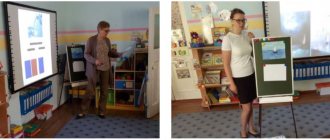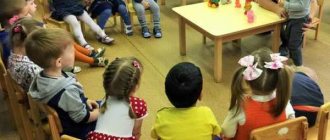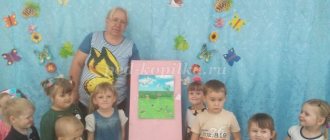Summary of a lesson on cognitive development of preschoolers
Summary of direct educational activities based on a systemic activity approach in the preparatory group “Magic Fireworks”
Target
: development of children’s cognitive activity through experimentation in artistic activities.
Educational objective:
Formation and expansion of children's knowledge about the properties of air.
Developmental task
: Development of children's cognitive activity, imagination, logical thinking, ability to make inferences, comparisons, judgments, the ability to draw conclusions.
Educational task:
Fostering a culture of communication while working together with peers, a desire to work in a team, and to provide assistance to partners on a task.
Technology used
: system-activity approach.
The form of organization of educational activities used:
subgroup work.
Form of work:
conversation, observation, discussion, questions, conducting experiments.
Equipment:
Cups, water, cocktail straws, sheets of paper, paints of different colors, soap solution, sponges, chalk, peas, stopwatch, letter, envelope, reproductions of paintings, pictures of artists, video.
Integration of educational areas
: cognitive development;
artistic and aesthetic development. Progress of the lesson: Introduction to the situation
Children enter the group. The teacher meets the children:
Hello guys! I am glad to see you so beautiful, kind, and in a good mood! We will spend this time together. May this meeting bring joy and many new interesting experiences. Let's make each other happy!
Guys, this morning I received a video letter, let’s see who it’s from...
VIDEO LETTER from Nolik
“Dear guys, hello! I am contacting you because I need your help. Simka asked me to draw fireworks for her birthday. But I have to draw it with air. I know what fireworks are, but I don’t know how to draw with air. Help me please. “Well, guys, let’s help Nolik? - Yes! - Do you know how to draw with air? - No! - Let's figure it out. Updating knowledge:
- Let's first remember, what profession do people draw? - Artists
Vosp: Children, but artists are different: architects, animators, designers, restorers... (the teacher accompanies the story by showing pictures). —What do artists usually paint with? - children's answers
Vosk: and not only, look, this picture was made with a ballpoint pen, a simple pencil, colored pencils, wax crayons, watercolors and gouache paints (the teacher accompanies the story with a demonstration) - Can artists paint with air? - we don’t know - Let’s figure it out further then. Let's remember, who knows what about air? - children's answers - Let's check if we really need air. I have a stopwatch, now we will all take a breath and not breathe - let's see how long we can last without it. Children complete the task. - So you lasted just a little bit. Let's see how much time has passed - 8 seconds. - What else do we know about air? - Air is everywhere - Can we touch the air? - No - Can we drink it? - No - So the air is neither liquid nor solid. Is it possible to catch air? Let's try to catch the air using a bag. -Can we feel it? but as? - Breathe The teacher opens the fan and blows on the children - What is happening? - Wind. I see you and I are a little tired. Let's get moving. Physical education minute.
We'll rest a little, stand up, take a deep breath. Hands to the sides, forward. The children walked through the forest and watched nature. They looked up at the sun, and the rays warmed them all. Miracles in our world: Children became dwarfs. And then everyone stood up together, We became giants. Let's clap and stamp our feet! We had a good walk and got a little tired. Guys, where else is there air? To check this, we will experiment a little. Where are the experiments carried out? So you and I will conduct experiments in the laboratory. Put a piece of sponge into the water. What's happening? Are there air bubbles in the sponge? - Yes - Is there any in the chalk? - Yes - So, let's conclude that air is everywhere. And if it is everywhere, then there is air inside us too? - Probably - Let's check. We take in air by inhaling and exhale it through the tube. (Children complete the task). That's how many air bubbles we got! - What conclusion can we draw now? “We also have air.” - Amazing! Now we know a lot about air, we know who can draw and with what. Let's now experiment with this and be artists of the air. The teacher shows the children the prepared material necessary for the experiment. The children come to the table. - Guys, look what we have here. Which of these is necessary for drawing? - Children's answers (paints, water, paper, cups) - Have you noticed that there is not a single brush or pencil here? - Yes - So what do you think we will draw with? - With tubes! - Almost, the tubes will help us, but we will draw, as Nolik requested, with air. Remember how to get air from tubes? - We will blow! - Fine. For magic we will need: a little soap solution, tubes, paints with water, cups and paper. Let's start experimenting. The teacher invites the children to pour some water into cups, add paint and stir it with a straw, add a soap solution and blow out air - bubbles - with a straw. When a lot of foam appears, apply a sheet of paper to the neck of the glass - you will get an imprint - a fireworks display. Children can swap cups to create colorful fireworks. - Well, did everyone succeed? - Yes - You did very beautiful work. How can we send these works to zero? - Put it in an envelope. - How do we put them in an envelope? We'll ruin all the fireworks then, won't we? - We need to let them dry. - And when they dry, we will put them in an envelope and send them to Nolik.



